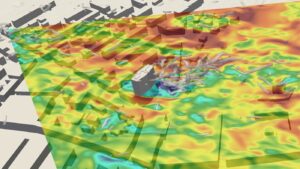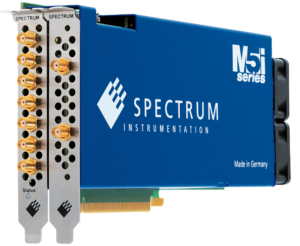Keeping track of a vast number of dust particles moving in the wind generates a huge amount of data
Bangalore, India, August 24, 2023: A common way to design a large new building is to make a scale model and test it in a wind tunnel. This has been a recognised test for over 50 years, but it is known to underestimate peak loads, so correction factors are applied to provide a safety margin. Another drawback is that the wind just comes from one direction at a time, whereas in the real world, gusts and large eddies can fluctuate from many different directions at once. A Danish company, Vind-Vind, is developing a new turbulence model to capture the effects of wind on a building in natural conditions. This modelling uses real-world data to enhance its accuracy, gathered with a LIDAR system using 10 ns pulses. Particles in the air reflect the laser, and the changes in the returned light due to the Doppler effect are analysed using the latest flagship product of Spectrum Instrumentation, the ultrafast M5i.3321 digitizer card.
Watch the wind simulation video (11 sec, 132 MB): https://spectrum-instrumentation.com/videos/3D.mov

Fig. 1: Wind interacts with buildings in very complex ways. This screenshot from the video shows wind velocities at 33 m height relative to the innovative Lidar system located at the upper left corner.
Per Jrgensen, CEO of Vind-Vind, explained: “At present, there are two ways to measure wind movement: either low resolution over a long distance of several kilometres or high resolution over a short distance of a few hundred meters. We created a new LIDAR-based instrument to measure long distances at high resolution. Key to this is the ability of the Spectrum digitizer card to capture the data at its very high sampling rate of 3.2 gigasamples per second with 12-bit resolution. This is actually more than we need, but it gives us the margin to allow for ‘noisy’ conditions and weak signals. The extra bandwidth also means that we can immediately identify and filter out high-frequency noise, leaving only low-frequency noise to be eliminated later when processing the data.”
As can be imagined, keeping track of a vast number of dust particles moving in the wind generates a huge amount of data. Vind-Vind was initially going to use an FPGA platform but rejected this approach as being too complex to programme and not having enough compute power to handle the large amount of data being created every second. The data problem was solved by using Spectrum’s SCAPP drivers (Spectrum’s CUDA access for parallel processing). In this solution, the M5i digitizer, with its 16-lane PCIe interface, sends the collected data at up to 12.8 gigabytes per second directly to a CUDA-based graphics card instead of the PC CPU. The graphic card, in this case a Nvidia Quadro A4000 with a GPU with 6,144 cores, is processing the data much faster than the CPU of the PC with only 6 or 8 cores.
Vind-Vind’s initial goal for its computer modelling is to assess how the turbulence compares to the measured turbulence in an urban environment. After that, turbulence modelling will be improved to include the effects of a higher section of the atmosphere with wind gusts from different directions. Accurate data gathered in the real world can then be used to verify and validate the predictions of the 3D computer simulation. “With proven accuracy, our 3D wind modelling can be used to provide greater levels of safety and wind comfort as it will predict the complex nature of the real world and not the constrained version of the wind tunnel,” added Jorgensen. “Eventually it will mean that the considerable overspecification that architects have to build in because of the inaccuracy of wind tunnel models can be reduced. This means improving sustainability and saving costs by cutting down on the unnecessary use of materials.”

Fig. 2: The M5i.3321-x16 digitizer card offers 3.2 GS/s sampling speed, 12 bit resolution and 1 GHz bandwidth on each of the two channels. The M5i.33xx family has 5 different models with 10 GS/s top speed and over 3 GHz as highest bandwidth.
The company envisages that its 3D wind modelling will prove invaluable for the many situations where typical wind tunnels cannot provide useful results, such as the complex wind interactions of atmospheric turbulence with urban environments, clusters of wind turbines, bridges, or airports.
Vind-Vind consists of two sister companies: PJ Science ApS has its focus on producing and selling innovative LIDAR systems, and Vind-Vind ApS is the consulting company doing wind analysis for the construction industry. More info: www.vindvind.com
Also read: Trending Technologies to change our world in Next 5 Years
Do Follow: CIO News LinkedIn Account | CIO News Facebook | CIO News Youtube | CIO News Twitter
About us:
CIO News, a proprietary of Mercadeo, produces award-winning content and resources for IT leaders across any industry through print articles and recorded video interviews on topics in the technology sector such as Digital Transformation, Artificial Intelligence (AI), Machine Learning (ML), Cloud, Robotics, Cyber-security, Data, Analytics, SOC, SASE, among other technology topics






